WE KNOW TIRES. IT'S OUR BUSINESS.
As the innovators behind the first all-season radial and the first commercially available RunOnFlat tires, Goodyear has been leading the way in the tire technology for over 100 years.
As the innovators behind the first all-season radial and the first commercially available RunOnFlat tires, Goodyear has been leading the way in the tire technology for over 100 years.
Replacing worn tires is a great way to help your vehicle to achieve its optimum traction for responsive handling and braking. If you're having problems deciding when to start shopping, follow these two simple tips to see if it's time for new tires:
Tread depth is an important indicator of tire wear. Check your tread depth to determine if your need to replace your current tires.
Be sure to check your tires for any signs of wear, such as discoloration or cracks. If you notice any signs of damage or wear on your tires, come in to your local Goodyear Auto Service for a free inspection by our tire experts.
The first thing you'll need when tire shopping is your tire size. Jot it down from your tire's sidewall. It may also be listed on the placard inside your driver's side door or in your owner's manual.
The make and model, as well as how you use the vehicle, are all important to selecting the right tire. Your tire choice may be different if you just drive around town, take frequent long trips or for driving both on- and off-road.
You should also keep in mind what tire benefits are most important to you. You may want great wet traction, traction in snow, high-performance traction or off-road capability. The more specific you are, the better tire choice you can make.
You may have several tire options. Our sales professionals can discuss the features and benefits of each tire to make sure you have confidence in the choice you make. Once you've settled on a set of tires you are happy with, it's time for the installation.
Once you select a tire, the installation process begins. This usually takes at least 30 minutes. There are several itemized services required to properly install your new tires, regardless of where you make your purchase. The following services are included in your installation:
Buying tires is an important process, but it doesn't have to be intimidating. Talk to our tire sales professionals about how you drive and they will help you find the right set of tires for your vehicle.
Sometimes it's hard to find the time to properly maintain your vehicle. While your vehicle is at your Goodyear Auto Service getting new tires, you may want to consider the following services while you're here:
The “right amount” of air for your tires is specified by the vehicle manufacturer and is shown on the vehicle door edge, door post, glove box door or fuel door. It is also listed in the owner’s manual.
With a little explanation it's easy to understand what all of the letters and numbers mean on your tire's sidewall. The numbers are indicators of the size, type, and performance of the tire.
Tire Type The letter "P" at the beginning of the "Tire Size" tells us the tire is a P-Metric tire, referring to tires made to certain standards within the United States, intended for Passenger vehicles.
If a tire size has no letters at the beginning, this indicates a Euro metric tire. P-Metric and Euro-Metric tires may have different load capacities.
The letters "LT," either at the beginning or at the end of the tire size indicate the tire was designed for light trucks. Vehicle manufacturers equip some light trucks with "LT" type tires. These tires generally require higher inflation pressures than passenger tires.
Consult your owner's manual or tire placard for the recommended tire size and inflation pressure for your vehicle.
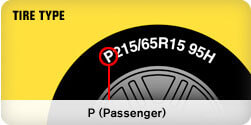
Tire Width is the width of the tire measured in millimeters from sidewall to sidewall. The first three-digit number in the tire size refers to the tire width. For instance, in a size P215/65 R15 tire, the width is 215 millimeters.
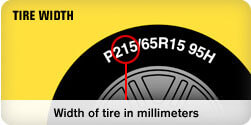
Aspect Ratio is the ratio of the height of the tire's cross-section to its width. The two-digit number after the slash mark in a tire size is the aspect ratio. For example, in a size P215/65 R15 tire, the 65 means that the height is equal to 65% of the tire's width. The bigger the aspect ratio, the bigger the tire's sidewall will be.
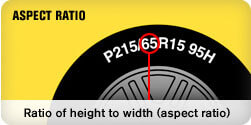
Construction. The letter "R" in a tire size stands for Radial, which means the layers run radially across the tire.
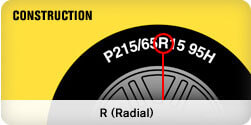
Wheel Diameter is the size of the wheel measured from one end to the other. It tells us the size of the wheel that the tire is intended to fit. A size P215/65 R15 tire is made for a wheel with a 15" diameter.
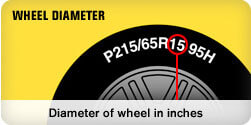
Load Index indicates the maximum load that the tire can support when properly inflated. You'll also find the maximum load on the tire sidewall, in both pounds and kilograms.
Speed Rating tells you the maximum speed capability of a tire. Often speed ratings are matched to the top speed capability of the vehicle. For example, a tire with an H-speed rating has a maximum speed capability of 130 mph or 210 km/h. Goodyear does NOT recommend exceeding legally posted speed limits.
DOT Symbol: The letters "DOT" on the sidewall indicate that the tire complies with all applicable Federal Motor Vehicle Safety Standards in the United States.
Tire Identification Number: The series of letters and numbers following the letters "DOT." The TIN consists of up to 12 numbers and letters to identify the factory location and the week and year the tire was manufactured.
UTQG stands for Uniform Tire Quality Grading, a rating system developed by the U.S. Department of Transportation to provide consumers with information to help them purchase tires based on their relative treadwear, traction and temperature capabilities.
Traction grades indicate the wet traction of a tire under a controlled test. A tire with an "AA" rating offers outstanding traction in wet conditions.
| Traction Grades |
|---|
| AA |
| A |
| B |
| C |
Temperature grades indicate the ability of the tire to withstand and dissipate destructive heat. A tire with a higher temperature grade is able to operate at higher speeds.
| Temperature Grades | Speeds in mph |
|---|---|
| A | Over 115 |
| B | Between 100 and 115 |
| C | Between 85 and 100 |
Treadwear grades are based on standardized government tests to help predict the expected treadwear of a tire. For example, a tire with a treadwear grade of 200 should last twice as long as a tire with a treadwear grade of 100.
Balancing your wheels helps prevent uneven tire wear and minimizes wheel vibration. Balancing is performed anytime you put new tires on your car and should be performed every 6,000 miles or as recommended by your vehicle manufacturer.
An unbalanced tire can cause premature wear of the tire, strut and shock, wheel vibration, poor handling, and excessive noise. Unbalanced tires also cause reduced mileage expectancy. Have your tires balance checked at your Goodyear Auto Service if you notice any of these symptoms.
A wheel balance consists of small weights placed around the wheel to help balance the tire and wheel assembly, ensuring a smooth and comfortable ride.
Rotating the position of each tire helps equalize tread wear, helping to maximize the life of your tires. Front tires tend to wear faster than rear tires on front wheel drive vehicles due to added pressure/resistance from steering. If your tires aren't rotated regularly, they may need to be replaced prematurely. Rotating the position of each tire helps equalize treadwear to help maximize the life of your tires.
Plan to have your tires rotated every 6,000 miles.
Properly repairing a tire that has deflated or is losing air or has picked up a nail, screw or sharp object is critical. Some tires may be repaired if they continually lose air or have a puncture in the tread area. Whenever you have a tire issue, be sure to have it inspected by a tire professional at your Goodyear Auto Service to determine whether it can be repaired or needs to be replaced.
Tire repairs need to be performed correctly in accordance with strict industry standards. Before any repair, a service professional must properly inspect the tire by removing it from the wheel and inspect the outside and inside to determine the extent of the damage and to determine if the tire can be repaired.
When a tire can be repaired, your Goodyear Auto Service performs a complete repair by using a tire repair plug and patch combination. Once completed, the technicians will rebalance the tire and rim assembly and reset the tire pressure monitoring system (TPMS), if applicable.
You should monitor your tread depth closely once it reaches 4/32 inch deep. Here's how to assess your tread depth:
| 4/32" or deeper | Good |
| 3/32" | Replace Tires Soon |
| 2/32" or less | Replace Tires Now |
There are several popular ways to check your tire tread depth. One easy way is the penny test. Simply insert a penny into your tire's tread groove with Lincoln's head upside down and facing you. If you can see all of Lincoln's head, your tread depth is less than 2/32 inch and it's time to replace your tires.

Another easy coin test is the quarter test. Insert a quarter into your tread groove. If the tread touches Washington's head, you have at least 4/32 inch of tread remaining.

Don't have any change on you? No problem. Another way to check tread depth is to look at the treadwear indicator bar that's molded into your tires. The bars are located at the bottom of the tread grooves in several locations around the tire. When these bars become visibly flush with the adjacent ribs the tire has no more than 2/32" of tread remaining. This is a visible indication that the tire should be replaced.
